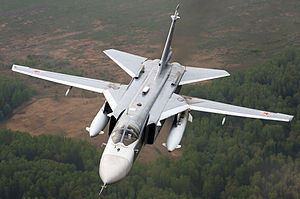Sukhoi T-6
| Su-24 | |
|---|---|
 |
|
| Su-24M of the Russian Air Force, May 2009 | |
| Role | All-weather attack aircraft |
| National origin | Soviet Union / Russia |
| Manufacturer | Sukhoi |
| Designer | Ye. S. Felsner (from 1985) L.A. Logvinov |
| First flight | T-6: 2 July 1967 T-6-2I: 17 January 1970 |
| Introduction | 1974 |
| Status | In service |
| Primary users |
Russian Air Force Ukrainian Air Force Kazakh Air Force Islamic Republic of Iran Air Force |
| Produced | 1967–1993 |
| Number built | Approximately 1,400 |
| Unit cost |
US$24–25 million in 1997
|
The Sukhoi Su-24 (NATO reporting name: Fencer) is a supersonic, all-weather attack aircraft developed in the Soviet Union. The aircraft has a variable-sweep wing, twin-engines and a side-by-side seating arrangement for its two crew. It was the first of the USSR's aircraft to carry an integrated digital navigation/attack system. It remains in service with the Russian Air Force, Ukrainian Air Force, and various air forces to which it was exported.
One of the conditions for accepting the Sukhoi Su-7B into service in 1961 was the requirement for Sukhoi to develop an all-weather variant capable of precision air strikes. Preliminary investigations with S-28 and S-32 aircraft revealed that the basic Su-7 design was too small to contain all the avionics required for the mission. OKB-794 (later known as Leninets) was tasked with developing an advanced nav/attack system, codenamed Puma, which would be at the core of the new aircraft. That same year, the United States proposal for their new all-weather strike fighter would be the TFX. The resulting F-111 would introduce a variable-geometry wing for greatly increased payload, range, and low-level penetration capabilities.
In 1962–1963, Sukhoi initially set out to build an aircraft without the complexity of moving wings like the F-111. It designed and built a mockup of S-6, a delta wing aircraft powered by two Tumansky R-21F-300 turbojet engines and with a crew of two in a tandem arrangement. The mockup was inspected but no further work was ordered due to lack of progress on the Puma hardware.
...
Wikipedia
